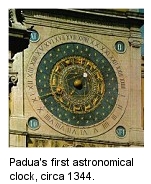
Gothic Design
Learn More.
| HOME Feature Articles Stone Carver's Tour Virtual Cathedral Cathedral Tours Gothic Field Guide GOTHIC GEOMETRY Virtual Abbey Medieval Art Tours Castle Tours Links Resources About The Site FAQ |
|
Then, Brother Gerbert, who later became Pope Sylvester II, invented a simple mechanism in 966 that rang bells at regular intervals throughout the day to call his brethren to prayer. It was the beginning of mechanical clocks as we know them today. Soon, cathedral towers were providing the rest of the faithful with their first glimpse of a right proper (although not always accurate) mechanical clock. The earliest of these is credited to Jacopo de Dondi, who designed an astronomical clock for the cathedral tower in Padua in 1344. Curiously, almost every zodiac sign surrounds the clock face except for the balanced scales of Libra. (As the story goes, it was deliberately left out of the lineup by guild workers who felt they weren't treated fairly in salary negotiations.) Strasbourg Cathedral's mechancial clock appeared in 1354, and was followed by the third, and most elaborate mechanical clock, built in Prague's Town Hall in 1410. This being the Middle Ages, the Prague clock depicted earth at the center of the universe - with the sun, moon, and stars revolving around it. Blue and red halves separated day and night. With embellishments added over the centuries, today the clock remains a veritable funhouse of timekeeping. And it remains the city's most popular (and free) attraction, still packing them in as a mechanical rooster loudly crows, signalling the parade of the 12 Apostles, who enter from two open windows. The hourly show winds down with a 'hour glass of life' running on empty. A skeleton, rattling its ancient bones, finally ends the observance that, an hour later, begins all over again as it has done for centuries. Check out more related resources to this article on the Web: The Astronomical Clock - Prague More
Medieval Inventions...
|
Sponsored
Links
copyright © 2017
 The
Egyptians were big on sundials. The Chinese favored water clocks.
In the early Middle Ages, time was first marked down the length
of a candle in hourly increments. Next
came large hour glasses, which were only good for an hour...or two.
The
Egyptians were big on sundials. The Chinese favored water clocks.
In the early Middle Ages, time was first marked down the length
of a candle in hourly increments. Next
came large hour glasses, which were only good for an hour...or two.